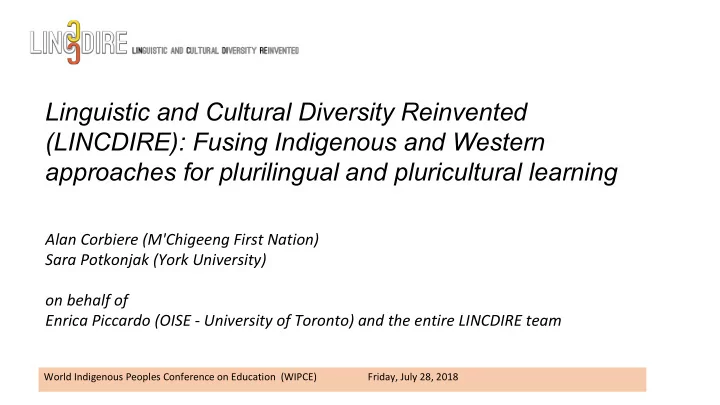

Linguistic and Cultural Diversity Reinvented (LINCDIRE): Fusing Indigenous and Western approaches for plurilingual and pluricultural learning Alan Corbiere (M'Chigeeng First Nation) Sara Potkonjak (York University) on behalf of Enrica Piccardo (OISE - University of Toronto) and the entire LINCDIRE team World Indigenous Peoples Conference on Education (WIPCE) Friday, July 28, 2018
3-year Partnership Development Grant Head institution Funding agency Principal investigator Enrica Piccardo
Participating Institutions
Background 60 million Americans 65+ aboriginal Around 7 million speak a language other languages and several Canadians speak a than English (382 heritage languages different languages with non-official language (Census Canada, 2012) 134 native languages) (Statistics Canada, 2012) Site for Language Management in Canada (SLMC) (US census Bureau, 2015) Schools are not prepared to take Lack of recognition of advantage of linguistic diversity non-dominant languages in > decline of home languages mainstream education (Wiley & (Cantoni, 1997; Crawford, 2000). and Lukes, 1996; Hornberger, 2001). inequities in education
Language framework based on lifecycle (Anderson, 2011) AHWS Lifecycle wheel (“Generations to Come”, 1993)
Cultural basis for learning and teaching (Stairs, 1995)
Three key aspects of our pedagogical model 1. The medicine wheel 2. Plurilingualism 3. Action-oriented approach
1) The Medicine wheel Self-Reflection on: My Chosen Work • my language learning Mind • plurilingual awareness and skills Decisions • my learning strategies Focus on Metalinguistic and Focus on learning experiences & Metacognitive Awareness Focus on my roots/community & Self-Reflection on my non-verbal strategies intercultural growth roots and Actions Values Spirit inter-/cross-cultural Body encounters Self-Reflection on My Learning Experiences Emotions Reactions Focus on my story Self-Reflection on self as plurilingual being
2) Plurilingualism ● Students are holistic, ● Students ‘start from scratch’ plurilingual/cultural beings: one with every new language network with different connections learned - prior languages as obstacles ● Students draw on previous ● Students are collections of experiences - mother tongue is separate monolingual, always present & prior languages monocultural selves as potential resources ● errors are a natural part of learning ● errors should be avoided (COE, 2001; Piccardo, 2014)
Making space for students’ plurilingual selves Reflection and Fostering a sense of Learning is a awareness-raising freedom with conscious journey processes should be languages encouraged student-created resources
3) Action-oriented approach We speak To introduce To get to others information ourselves “Learners must learn We listen the language, not just To learn To learn about about the language” important to stories our history lessons (Piccardo, 2014) We write a To thank To keep in someone for a touch with letter gift relatives
A digital environment organized Language Integration Through around four sections E-portfolio My plurilingual Do a reflection portrait My tasks My linguistic profile
scenarios: The action-oriented approach Learning is set in a context that relates The fall feast to everyday life Every year, there is a Fall Feast to feed the spirits. This year, you have been asked to work as a guide during the feast. You will prepare an invitation for your parents and grandparents, and then guide your family through the feast, teaching them about each type of food, how it was cooked, and its importance to the feast. Students’ other Target learners (CEFR level/grade): A2 learners/ elementary languages are also Main target language: Ojibwe encouraged Other languages involved: English / any other languages spoken by students
Mind During the feast students Students reconstruct the Decisions are guides and language history of the feast using Focus on Metalinguistic and Metacognitive Awareness ambassadors, so parents visual clues. Focus on learning experiences & Focus on my roots/community & can learn some words about the feast from the non-verbal strategies intercultural growth children. Values Actions Spirit Body Students use their bodies to Emotions Reactions express how they feel about Focus on my story a particular food item (“I like/ I don’t like) Invite students to draw a picture of their facial expression to show their level of excitement.
Medicine Wheel Reflections I’ve learned something from Spirit quadrant reflection this task that I would like to share with others. Sharing stories and experiences helped me and my classmates learn more about the topic.
Fall Feast vocabulary: plurilingual group activity Look at the list of Fall Feast vocabulary. In your group, brainstorm a list of the same vocabulary words in any/all other languages you know. How do the vocabulary terms compare across languages? Which languages are the most similar/different?
Conclusion Making the Medicine Wheel and aboriginal epistemology accessible to non-indigenous teachers Making latest non-indigenous conceptualization of language education accessible to indigenous teachers
Project Members PI: Enrica Piccardo ( OISE – University of Toronto & Université Grenoble-Alpes) Co-Applicants: Aline Germain-Rutherford (University of Ottawa) & Geoff Lawrence (York University) • Alan Corbiere (M’Chigeeng First Nation - Aboriginal Languages and Cultures, Canada) • Anette Guse (University of New Brunswick) • Alana Johns (University of Toronto,) • Coralie Payre-Ficout (Université Grenoble-Alpes, France) Norman Sieweke (Edmonton Public Schools - Institute for Innovation in Second Language Education) • • Nicola Townend (University of Toronto Schools) • Mary Ann Corbiere (University of Sudbury) Research Assistants • Kimberly Cho (OISE-UofT) • Angelica Galante (OISE-UofT) • Kris Johnston (York) • Mama Ni Owoo (OISE-UofT) • Yecid Ortega (OISE-UofT) • Sara Potkonjak (York) Merci ! Miigwetch! Danke! Grazie! Thank you! • Michael Koslowski (York)
Recommend
More recommend